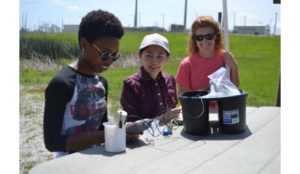SREL Study catches industrial metals before they reach surface water
Thomas Gardiner
Augusta Chronicle
(706) 823-3339 or thomas.gardiner@augustachronicle
Posted June 25, 2017

Since its inception in 1951, the Savannah River Ecology Laboratory at Savannah River Site has advanced studies in biodiversity and ecological impacts of site activities and environmental change. As knowledge advances, so too do capabilities, and the lab now studies man-made wetland systems to isolate and prevent metals from Savannah River Site nuclear activities from reaching outside water systems.
According to study director Dr. Gary Mills, the manmade wetland filtration system is not a new idea.
“Using the wetlands to filter these metals is a novel idea, but the concept isn’t new. It’s been used in agriculture and other industries for years to keep fertilizers or pesticides from running off into water supplies,” he said.
Mills said the study is important because these industrial waters flow into Upper Three Run Creek, which is a direct tributary to the Savannah River. One man-made wetland system lies just behind the tritium facility on site.
Tritium is a radioactive isotope of hydrogen. It is created and stored at SRS to maintain the nation’s nuclear arsenal and the facility is the nation’s only tritium manufacturer. Tritium releases, however, aren’t let into the creek.
Those releases are done via air dispersal and through a tree farm irrigation system. According to Mills, the metals coming from the waters leaving the facility include zinc, copper and mercury; the latter two are the most dangerous for neighboring ecosystems.
Upper Three runs is one of the most bio-diverse water systems ever studied by scientists, and Mills said that adds to its importance. He said the creek maintains such diversity because it was not subjected to discharge of hot water from reactors during plutonium production during the Cold War.
Post-graduate associate Xiaoyu Xu said the study is designed to determine how successfully the man-made wetland can utilize natural processes through bacteria and other organisms to isolate the metals.
“You can’t find such a place with these specific metals to do this study. This wetland has a lot of organic material every year and we get to find out how much metal we are getting out,” she said.
The reservoirs are designed with a special layer of organic material that holds bacteria. That bacteria creates chemicals that then bind to the metal, reducing the bio-availability. Reducing bio-availability keeps the metal out of the food supplies for insects, thereby keeping the metals out of the bodies of birds, amphibians, fish and human beings. The reservoirs were created with a layer of clay and plastic to prevent any mixing of contaminated water with groundwater.
The laboratory contains special equipment, including machines designed to determine the amount of metals in a water sample with as much accuracy as a few parts per billion, heats the samples to 7,000 degrees Kelvin.
The study is in its 10th year. Samples from soil and water show the metals settle in the sediment layer along the bottom of the reservoirs. Mills said they are being kept our of Upper Three Runs Creek, but further study is needed.
“One question we are trying to answer now is how long it will take for the metals to be pulled into the next layer,” he said.
The man-made wetlands were established in 2007 and are expected to have a 20-year life span. Mills said the idea is to apply this method to future environmental protection practices, given the study can show natural bio-geo-chemical processes are taking place.
“We have also started learning about genetic defects from exposure in plants and animals,” Mills said. “We have seen them passed on from parent to offspring through one or two generations, even if the offspring weren’t raised or grown in the same environment. That’s not just in aquatic ecosystems but that applies to people too.”
